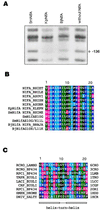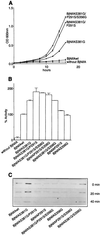Reciprocal domain evolution within a transactivator in a restricted sequence space
- PMID: 10716734
- PMCID: PMC16236
- DOI: 10.1073/pnas.97.7.3314
Reciprocal domain evolution within a transactivator in a restricted sequence space
Abstract
offhough the concept of domain merging and shuffling as a major force in protein evolution is well established, it has been difficult to demonstrate how domains coadapt. Here we show evidence of coevolution of the Sinorhizobium meliloti NifA (SmNifA) domains. We found that, because of the lack of a conserved glycine in its DNA-binding domain, this transactivator protein interacts weakly with the enhancers. This defect, however, was compensated by evolving a highly efficient activation domain that, contrasting to Bradyrhizobium japonicum NifA (BjNifA), can activate in trans. To explore paths that lead to this enhanced activity, we mutagenized BjNifA. After three cycles of mutagenesis and selection, a highly active derivative was obtained. Strikingly, all mutations changed to amino acids already present in SmNifA. Our artificial process thus recreated the natural evolution followed by this protein and suggests that NifA is trapped in a restricted sequence space with very limited solutions for higher activity by point mutation.
Figures




References
-
- Henikoff E S, Greene A, Pietrokovski S, Bork P, Attwood T K, Hood L. Science. 1997;278:609–614. - PubMed
-
- Doolittle R F. Annu Rev Biochem. 1995;64:287–314. - PubMed
-
- Doolittle R F, Bork P. Sci Am. 1993;269:50–56. - PubMed
-
- Netzer W J, Hart F U. Nature (London) 1997;388:343–349. - PubMed
-
- Chothia C. Nature (London) 1992;357:543–544. - PubMed
Publication types
MeSH terms
Substances
LinkOut - more resources
Full Text Sources

